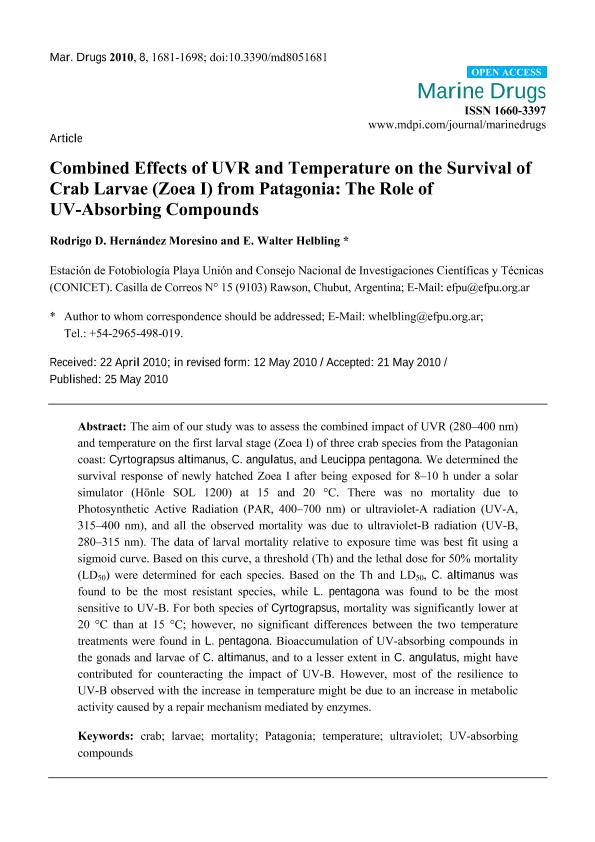Artículo
Combined effects of UVR and temperature on the survival of crab larvae (Zoea I) from Patagonia: The role of UV-absorbing compounds
Fecha de publicación:
05/2010
Editorial:
Molecular Diversity Preservation International
Revista:
Marine Drugs
ISSN:
1660-3397
Idioma:
Inglés
Tipo de recurso:
Artículo publicado
Clasificación temática:
Resumen
The aim of our study was to assess the combined impact of UVR (280-400 nm) and temperature on the first larval stage (Zoea I) of three crab species from the Patagonian coast: Cyrtograpsus altimanus, C. angulatus, and Leucippa pentagona. We determined the survival response of newly hatched Zoea I after being exposed for 8-10 h under a solar simulator (Hönle SOL 1200) at 15 and 20 °C. There was no mortality due to Photosynthetic Active Radiation (PAR, 400-700 nm) or ultraviolet-A radiation (UV-A, 315-400 nm), and all the observed mortality was due to ultraviolet-B radiation (UV-B, 280-315 nm). The data of larval mortality relative to exposure time was best fit using a sigmoid curve. Based on this curve, a threshold (Th) and the lethal dose for 50% mortality (LD50) were determined for each species. Based on the Th and LD 50, C. altimanus was found to be the most resistant species, while L. pentagona was found to be the most sensitive to UV-B. For both species of Cyrtograpsus, mortality was significantly lower at 20 °C than at 15 °C; however, no significant differences between the two temperature treatments were found in L. pentagona. Bioaccumulation of UV-absorbing compounds in the gonads and larvae of C. altimanus, and to a lesser extent in C. angulatus, might have contributed for counteracting the impact of UV-B. However, most of the resilience to UV-B observed with the increase in temperature might be due to an increase in metabolic activity caused by a repair mechanism mediated by enzymes.
Palabras clave:
CRAB
,
LARVAE
,
MORTALITY
,
PATAGONIA
,
TEMPERATURE
,
ULTRAVIOLET
,
UV-ABSORBING COMPOUNDS
Archivos asociados
Licencia
Identificadores
Colecciones
Articulos(CCT-CENPAT)
Articulos de CTRO.CIENTIFICO TECNOL.CONICET - CENPAT
Articulos de CTRO.CIENTIFICO TECNOL.CONICET - CENPAT
Citación
Hernández Moresino, Rodrigo Daniel; Helbling, Eduardo Walter; Combined effects of UVR and temperature on the survival of crab larvae (Zoea I) from Patagonia: The role of UV-absorbing compounds; Molecular Diversity Preservation International; Marine Drugs; 8; 5; 5-2010; 1681-1698
Compartir
Altmétricas




